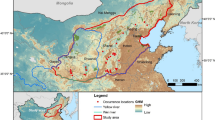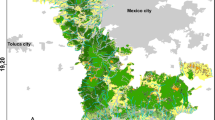Abstract
The Changbaishan reserve and the forests around it are one of the priority areas for Amur tiger (Panthera tigris altaica) recovery in northeastern China. Previous habitat suitability analyses only took the ecological requirements of tigers into consideration, so this study aims to determine habitat suitability for a tiger-prey community in the region, by analysing ungulate prey availability and habitat suitability for both predator and prey. Three prey species were found, using the snow tacking method: red deer (Cervus canadensis xanthopygus), wild boar (Sus scrofa), and roe deer (Capreolus pygargus). Habitat suitability was evaluated for tigers, red deer, and wild boar, using a multi-criteria evaluation (MCE) process. MCE results showed that (1) habitat suitability is generally low outside the reserve for all three species; (2) suitability values were the lowest for tigers due to high intensity of human impact in the area, with suitable habitat restricted to the centre of the reserve; and (3) red deer and wild boar would find pockets of suitable habitat outside the reserve. A combination of low forest quality and high human impact intensity imposes significant environmental pressure to those ungulates. To recover tiger population in Changbaishan, forest quality and human impacts should be properly managed, which should increase prey availability.








Similar content being viewed by others
References
Bai F, Sang W, Li G, Liu R, Chen L, Wang K (2008)Long-term protection effects of national reserve to forest vegetation in 4 decades: biodiversity change analysis of major forest types in Changbai Mountain Nature Reserve. China Sci Chin Ser Biol Sci 51:948–958
Bai F, Sang W, Axmacher JC (2011) Forest vegetation responses to climate and environmental change: a case study from Changbai Mountain, NE China. For Ecol Manag 262:2052–2060
Borkowski J, Ukalska J (2008) Winter habitat use by red deer and roe deer in pine-dominated forest. For Ecol Manag 255:468–475
Caroll C, Miquelle DG (2006) Spatial viability analysis of Amur tiger Panthera tigris altaica in the Russian Far East: the role of protected areas and landscape matrix in population persistence. J Appl Ecol 43:1056–1068
Chapron G, Miquelle DG, Goodrich JM, Legendre S, Clobert J (2008) The impact on tigers of poaching versus prey depletion. J Appl Ecol 45:1667–1674
Eastman JR (2006) Idrisi Andes guide to GIS and image processing. Clark University, Worcester, MA, USA
Georgii B (1980) Home range patterns of female red deer (Cervus elaphus L.) in the Alps. Oecologia 47(2):278–285
Georgii B, Schröder W (1983) Home range and activity patterns of male red deer (Cervus elaphus L.) in the Alps. Oecologia 58(2):238–248
Goodrich JM, Kerley LL, Smirnov EN, Miquelle DG, McDonald L, Quigley HB, Hornocker MG, McDonald T (2008) Survival rates and causes of mortality of Amur tigers on and near the Sikhote-Alin Biosphere Zapovednik. J Zool 276:323–329
Goodrich JM, Seryodkin I, Miquelle DG, Bereznuk SL (2011) Conflicts between Amur (Siberian) tigers and humans in the Russian Far East. Biological Conservation 144(1):584–592. https://doi.org/10.1016/j.biocon.2010.10.016
Han X, Oliver CD, Ge J, Guo Q, Kou X (2012) Managing forest stand structures to enhance conservation of the Amur tiger (Panthera tigris altaica). In: Stanturf et al (eds) (2012). A goal-oriented approach to forest landscape restoration. World Forests, p 16
He HS, Hao Z, Larsen DR, Dai L, Hu Y, Chang Y (2002) A simulation study of landscape scale forest succession in northeastern China. Ecol Model 156:153–166
Hebblewhite M, Zimmermann F, Li Z, Miquelle DG, Zhang M, Sun H, Mörschel F, Wu Z (2012) Is there a future for Amur tigers in a restored tiger conservation landscape in Northeast China? Anim Conserv 15(6):579–572
Hebblewhite M, Miquelle D, Robinson H, Pikunov DG, Dunishenko YM, Aramilev IG, Nikolaev IG, Salkina GP, Seryokdin IV, Gaponov VV, Litvinov MN, Kostyria AV, Fomenko PV, Murzin AA (2014) Including biotic interactions with ungulate prey and humans improves habitat conservation modeling for endangered Amur tigers in the Russian Far East. Biol Conserv 178:50–64
Hojnowski CE, Miquelle DG, MyslenkovA I, Strindberg S, Smirnov EN, Goodrich JM (2012) Why do Amur tigers maintain exclusive home ranges? Relating ungulate seasonal movements to tiger spatial organization in the Russian Far East. J Zool 287(4):276–282
Howells O, Edwards-Jones G (1997) A feasibility study of reintroducing wild boar Sus scrofa to Scotland: are existing woodlands large enough to support minimum viable populations. Biol Conserv 81:77–89
Jiang H, Peng C, Apps MJ, Zhang Y, Woodard PM, Wang Z (1999) Modelling the net primary productivity of temperate forest ecosystems in China with a GAP model. Ecol Model 122:225–238
Kamler JF, Jedrzejewsky W, Jedrzejewska B (2008) Home ranges of red deer in a European old-growth forest. Am Midl Nat 159(1):75–82
Kang A, Xie Y, Tang J, Sanderson E, Ginsberg JR, Zhang E (2010) Historic distribution and recent loss of tigers in China. Integrative Zoology 5:335–341
Kerley L, Goodrich JM, Miquelle D, Smirnov EN, Quigley HB, Hornocker MG (2002) Effects of roads and human disturbances on Amur tigers. Conserv Biol 16(1):97–108
Keuling O, Stier N, Roth M (2009) Commuting shifting or remaining?. Mammalian Biology 74(2):145–152. https://doi.org/10.1016/j.mambio.2008.05.007
Korean People’s Democratic Republic Academy of Science Institute of Geography & The Russian Academy of Science Far Eastern Branch Institute of Geography (KPDRASIG) (1998). A survey of tigers and prey resources in the Paektusan area, Lyangan province, North Korea, in winter, 1998
Kuijper DPJ, Cromsigt PGM, Churski M, Adam B, Jedrzejewska B, Jedrzejewski W (2009) Do ungulates preferentially feed in forest gaps in European temperate forest? For Ecol Manag 258:1528–1535
Lei X, Lu Y, Peng C, Zhang X, Chang J, Hong L (2007) Growth and structure development of semi-naturallarch-spruce-fir (Larix olgensis–Picea jezoensis–Abies nephrolepis) forests in northeast China: 12-year results after thinning. For Ecol Manag 240:165–177
Li Y, Zhang M, Jiang Z (2008) Habitat selection by wapiti (Cervus elaphus xanthopygus) in Wandashan Mountains, China, based on habitat availability. Acta Ecologica Sinica 28(10):4619–4628
Li Z, Zimmermanm F, Hebblewhite M, Purekhovsky A, Mörschel F, Zhu C, Miquelle D (2010) Study on the potential tiger habitat in the Changbaishan Area. China Forestry Publishing House, Beijing, China, China
Luan X, Qu Y, Li D, Liu S, Wang X, Wu B, Zhu C (2011) Habitat evaluation of wild Amur tiger (Panthera tigris altaica) and conservation priority setting in north-eastern China. J Environ Manag 92:31–42
Marcot BG (1996) Tiger habitat corridors in Far East Russia, Northeast China, and Northern North Korea: need for a conservation strategy. In: Report for: Ecologically Sustainable Development. USDA Forest Service, Pacific Northwest Research Station, Inc. and
Martins IA, Bitencourt M, Silveira CFP, Jardineiro KS (2009). Method proposal for habitat quality analysis for large mammals in a cerrado patch. Annals of the XIV Brazilian Symposium of Remote Sensing, Natal/RN:4043-4051. (In portuguese)
Matyushkin EN, Pikunov DG, Dunishenko YM, Miquelle DG, Nikolaev IG, Smirnov EN, Salkina GP, Abramov VK, Bazylnikov VI, Yudin VG, Korkishko VG (1996) Numbers, distribution, and habitat status of the Amur tiger in the Russian Far East: “Express-report”. Final report to the USAID Russian Far East Environmental Policy and Technology Project
Miquelle DG, Smirnov EN, Quigley HG, Hornocker MG, Nikolaev IG, Matyushkin EN (1996) Food habits of Amur Tigers in Sikhote-Alin Zapovednik and the Russian Far East, and implications for conservation. Journal of Wildlife Research 1(2):138–147
Miquelle DG, Smirnov EM, Merril TM, Myslenkov AE, Quigley HB, Hornocker MG, Schleier B (1999) Hierarchical spatial analysis of Amur tiger relationships to habitat and prey. In: Seidensticker J (ed) Riding the tiger: tiger conservation in human-dominated landscapes. Cambridge University Press, pp 71–99
Miquelle D, Darman Y & Seryodkin I (2011). Panthera tigris ssp. altaica. In: IUCN 2012. IUCN Red List of Threatened Species. Version 2012.1
Piao Z, Tang L, Swihart RK (2011)Human-wildlife competition for Korean pine seers: vertebrate responses and implications for mixed forests on Changbai Mountain, China. Ann For Sci 68:911–919
Sodeikat G, Pohlmeyer K (2003) Escape movements of family groups of wild boar Sus scrofa influenced by drive hunts in Lower Saxony, Germany. Wildl Biol 9(1):43–49
Stephens PA, Zaumyslova OY, Hayward GD, Miquelle D (2006) Collaborative study between Sikhote-Alin State Biosphere Zapovednik. University of Wyoming and USDA Forest Service, Wildlife Conservation Society
Sun B, Miquelle DG, Xiaochen Y, Zhang E, Hiyai. S, Goshen G, Pikunov DG, Dunishenko YM, Nikolaev IG, Daming L (1999) Survey of Amur tigers and FarEastern leopards in eastern Heilongjiang Province, China, and recommendations for their conservation. A final report to The Wildlife Conservation Society. 56 pages.
Tang L, Shao G, Piao Z, Dai L, Jenkins MA, Wang S, Wu G, Wu J, Zhao J (2010) Forest degradation deepens around and within protected areas in East Asia. Biol Conserv 143:1295–1298
Tian Y, Wu J, Kou X, Li Z, Wang T, Mou P, Ge J (2009) Spatiotemporal pattern and major causes of the Amur tiger population dynamics. Biodivers Sci 17(3):211–225
Wang X, Fang J, Zhu B (2008) Forest biomass and root–shoot allocation in northeast China. For Ecol Manag 255:4007–4020
Wikramanayake E, Dinerstein E, Sidenstickers J, Lumpkin S, Pandav B, Shrestha M et al (2010) A landscape-based conservation strategy to double the wild tiger population. Conserv Lett 4:219–227
Wildlife Conservation Society (WCS). (2010). A monitoring program for the Amur tiger thirteenth-year report.
Yang X, Xu M (2003) Biodiversity conservation in Changbai Mountain Biosphere Reserve, north-eastern China: status, problem, and strategy. Biodivers Conserv 12:883–903
Yang S, Jiang J, Wu Z, Li T, Yang X, Han X, Miquelle DG, Pikunov DG, Dunishenko YM, Nikolaev IG (1998). Report on the Sino-Russian joint survey of Far Eastern leopards and Siberian tigers and their habitat in the Sino-Russian boundary area, eastern Jilin Province, China, winter, 1998. A final report to the UNDP and The Wildlife Conservation Society. 42 pp.
Zhou S, Zhang M (2011) An integrated analysis into the causes of ungulate mortality in the Wanda Mountains (Heilongjiang Province, China) and an evaluation of habitat quality. Biol Conserv 144:2517–2523
Zhu W, Li Y, Li B (2010) Analysis of Amur tiger habitat on the lower reaches of the Tumen River. In: Liu X (ed) 3S techniques and habitat analysis for Chinese wildlife. China Forestry Press, Beijing (In Chinese)
Acknowledgements
This project was carried out with great support from Tsinghua University and Professor Xuehua Liu's research lab, and with invaluable support from the Changbai Mountain Academy of Sciences.
Availability of data
All data can be obtained with Felipe Perez (main author) upon reasonable request.
Author information
Authors and Affiliations
Contributions
All authors (Felipe Perez, Zhengji Piao, and Xuehua Liu) contributed to the study conception and design. Research, material preparation, data collection and analysis were performed by FP. ZP participated in field data collection. The first draft of the manuscript was written by FP, and XL commented on previous versions of the manuscript. All aforementioned authors read and approved the final manuscript.
Corresponding author
Ethics declarations
All authors involved in this manuscript are aware of and agree with its submission.
Ethics approval and consent to participate:
Not applicable
Consent to participate
Not applicable
Consent for publication
Not applicable
Competing interests
The authors declare no competing interests.
Additional information
Responsible Editor: Philippe Garrigues
Publisher’s note
Springer Nature remains neutral with regard to jurisdictional claims in published maps and institutional affiliations.
Rights and permissions
About this article
Cite this article
Perez, ., Piao, Z. & Liu, X. Habitat suitability for a community of Amur tigers (Panthera tigris altaica) and their prey in Changbaishan. Environ Sci Pollut Res 29, 12249–12260 (2022). https://doi.org/10.1007/s11356-021-16469-8
Received:
Accepted:
Published:
Issue Date:
DOI: https://doi.org/10.1007/s11356-021-16469-8




